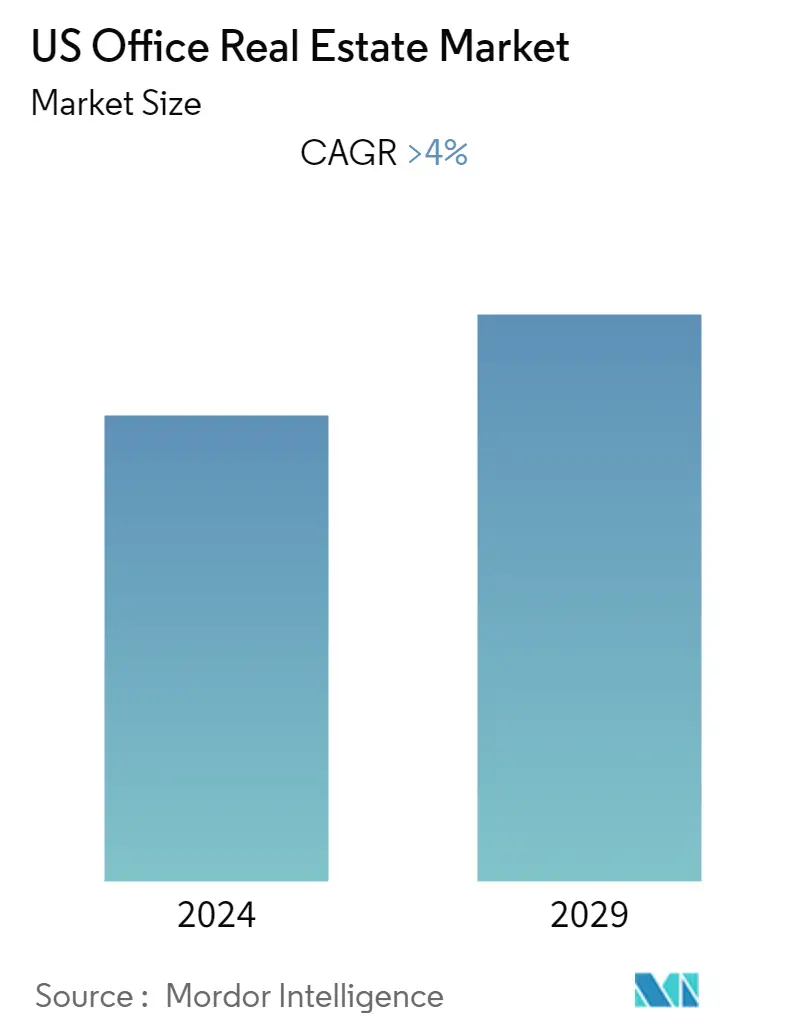Market Size of US Office Real Estate Industry

| Study Period | 2019 - 2029 |
| Base Year For Estimation | 2023 |
| Forecast Data Period | 2024 - 2029 |
| Historical Data Period | 2019 - 2022 |
| CAGR | > 4.00 % |
| Market Concentration | Low |
Major Players
*Disclaimer: Major Players sorted in no particular order |
US Office Real Estate Market Analysis
- The US office real estate market is poised to register a CAGR of greater than 4% during the forecast period.
- The COVID-19 pandemic hurt the US office sector a lot, and it may take a while for it to get better.The third quarter of 2021 was promising for the US office market. The vacancy rate was stabilizing, sublease space was decreasing, and net absorption was positive for the first time in Q3 2021 since Q1 2020.
- The property markets also felt the impact of the pandemic. Enterprises and frontline workers had to overcome many obstacles to stay in business. Almost every company in the property industry was compelled to make drastic changes, especially in the retail sector. To accommodate rising consumer demand and overcome acute shortages, retailers swiftly built up their home delivery and curbside pickup services while restructuring their supply chains. Many people who work from home have had to adjust their living environments on the fly. The emerging trend of the year is "flexibility."
- Vacancy rates rose throughout the American office real estate market during the coronavirus outbreak. The quarterly vacancy rate before 2020 was approximately 12 percent, but as the epidemic spread, it increased to more than 15 percent. Around 15.4 percent of office space nationwide was unoccupied in the third quarter of 2022. Businesses are wary of expanding or renewing leases because a sizable portion of the workforce now works from home or uses a hybrid working paradigm.
- In the third quarter of 2022, the fundamentals of the US office market remained negative. The third quarter of 2022 saw minus 4.4 million square feet (msf) of net absorption, bringing the year's total to negative 16.2 msf. With a quarterly net absorption of -2.2 msf and -2.0 msf, respectively, both major gateway and secondary markets lost the same number of tenants. Just 3.8% of the nation's total inventory is held in tertiary markets, which saw negative net absorption of 0.1 msf. Increasing vacancy is a sign of low demand, which is shown by consistently low net absorption, and high supply, which is shown by a lot of new construction in the works.
US Office Real Estate Industry Segmentation
Office real estate is the business of building buildings that companies from different industries can rent or buy.The goal of this report is to give a thorough look at the US office real estate market.It looks at the market insights, dynamics, technological trends, and government projects in the office real estate sector.
The US office real estate market is segmented by region (Northeast, Midwest, South, and West) and by sector (Information Technology (IT and ITES), Manufacturing, BFSI (Banking, Financial Services, and Insurance), Consulting, and Other Services). The report offers market size and forecasts in dollars (USD) for all the above segments.
| By Region | |
| Northeast | |
| Midwest | |
| South | |
| West |
| By Sector | |
| Information Technology (IT and ITES) | |
| Manufacturing | |
| BFSI (Banking, Financial Services, and Insurance) | |
| Consulting | |
| Other Services |
US Office Real Estate Market Size Summary
The US office real estate market is experiencing a gradual recovery following the significant disruptions caused by the COVID-19 pandemic. The market is characterized by a focus on flexibility, as businesses adapt to hybrid and remote work models, which have influenced demand for office space. Despite the challenges, such as increased vacancy rates and cautious leasing activity, there are signs of stabilization and growth in certain areas. The market is seeing a shift towards lower-cost secondary markets, particularly in the Sun Belt and West regions, where leasing activity has shown notable growth. The demand for well-equipped Class A office spaces in prime locations remains strong, as companies prioritize health and wellness features in their work environments.
The market landscape is relatively fragmented, with large firms leveraging their financial resources while smaller companies compete effectively in local markets. Key players in the industry include Turner Construction Company Inc., Kiewit Corporation, and Skanska USA Inc., among others. Recent mergers and acquisitions, such as the one involving Cressy Commercial Real Estate and Mno-Bmadsen, highlight the ongoing strategic movements within the market. Despite the challenges, the US office real estate market is poised for growth, with expectations of continued rent increases and a potential rise in demand for office space as the economy stabilizes and businesses adjust to post-pandemic realities.
US Office Real Estate Market Size - Table of Contents
-
1. MARKET INSIGHTS
-
1.1 Current Economic and Real Estate Market Scenario
-
1.2 Government Regulations and Initiatives in the Industry
-
1.3 Technological Innovations in Office Real Estate Market
-
1.4 Impact of Remote Working on Space Demand
-
1.5 Insights into Office Real Estate Construction Costs
-
1.6 Insights into Key Office Real Estate Industry Metrics (Supply, Rentals, Prices, Occupancy (%)/Vacancy (%))
-
1.7 Insights into Rents, Leasing, and Rental Yields in the Office Real Estate Segment
-
1.8 Insights into Key Trends on Rental and Leasing
-
1.9 Impact of COVID-19 on the Market
-
-
2. MARKET SEGMENTATION
-
2.1 By Region
-
2.1.1 Northeast
-
2.1.2 Midwest
-
2.1.3 South
-
2.1.4 West
-
-
2.2 By Sector
-
2.2.1 Information Technology (IT and ITES)
-
2.2.2 Manufacturing
-
2.2.3 BFSI (Banking, Financial Services, and Insurance)
-
2.2.4 Consulting
-
2.2.5 Other Services
-
-
US Office Real Estate Market Size FAQs
What is the current United States Office Real Estate Market size?
The United States Office Real Estate Market is projected to register a CAGR of greater than 4% during the forecast period (2024-2029)
Who are the key players in United States Office Real Estate Market?
Turner Construction Company Inc., Hensel Phelps Construction, Gilbane Building Co., Balfour Beatty LLC and Simon Property Group are the major companies operating in the United States Office Real Estate Market.

